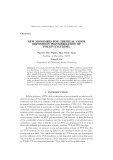
Thermal decomposition analysis
-
It was demonstrated that Poly(p-Xylylene) (PPX) could be prepared from α,α’-Bis(Alkoxy or Aryloxy) –p-Xylenes via chemical vapor decomposition (CVD)- method. This is one-step process and there are side products by the CVD-process. This effect depends both on the CVD- condition and the properties of the starting monomer. The structure and thermal behavior of the material were characterized by FTIR, UVvis spectroscopy, elemental analysis, wide-angle X-ray diffraction, DTA and DSC.
 14p
14p  12120609
12120609
 01-06-2020
01-06-2020
 16
16
 1
1
 Download
Download
-
In this study, reaction rates of the thermal decomposition reaction of 13 kinds of nitrates, which are main constituents of simulated HLLW (sHLLW), were investigated using thermogravimetrical instrument in a range of room temperature to 1000 °C.
 7p
7p  christabelhuynh
christabelhuynh
 30-05-2020
30-05-2020
 10
10
 1
1
 Download
Download












